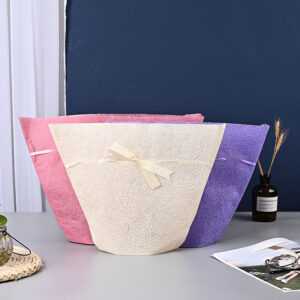The choice of material significantly impacts the properties of nonwoven fabrics.
Here are some ways in which the material selection affects the characteristics of nonwoven fabrics:
Fiber Type: The type of fiber used determines the inherent properties of the nonwoven fabric. Natural fibers like cotton or wool offer breathability, softness, and moisture absorption. Synthetic fibers like polyester or polypropylene provide durability, strength, and resistance to chemicals. Each fiber type contributes unique properties to the nonwoven fabric.
Fiber Diameter: The diameter of the fibers affects the fabric’s texture, strength, and filtration capabilities. Fine fibers create a soft and lightweight fabric with a higher surface area, suitable for applications requiring filtration or liquid absorption. Coarser fibers may result in a stronger and more rigid fabric.
Fiber Length: The length of the fibers influences the fabric’s strength, cohesion, and flexibility. Longer fibers tend to provide better strength and cohesion, resulting in a more durable fabric. Shorter fibers may offer increased flexibility and conformability.
Fiber Blend or Composition: Nonwoven fabrics can be made from a single type of fiber or a blend of different fibers. Blending fibers can combine their individual properties, such as strength, softness, absorbency, or flame resistance, to create a fabric with desired characteristics. The choice of fiber composition affects the fabric’s overall performance.
Bonding Method: The bonding method used to hold the fibers together also affects the fabric’s properties. Different bonding techniques, such as thermal bonding, chemical bonding, or needle punching, result in variations in strength, flexibility, breathability, and dimensional stability of the nonwoven fabric.
Surface Treatment: Nonwoven fabrics can undergo surface treatments, such as coatings or laminations, to enhance specific properties. These treatments can provide water repellency, flame resistance, antimicrobial properties, or improve the fabric’s appearance and feel.
Porosity and Breathability: The choice of material impacts the porosity and breathability of nonwoven fabrics. Some materials inherently offer high breathability, allowing air or moisture vapor to pass through easily. Other materials may have a more closed structure, limiting breathability.
Absorbency and Filtration: The material selection influences the fabric’s absorbency and filtration capabilities. Certain fibers have natural absorbent properties, making them suitable for applications like wipes or medical products. The choice of material can also affect the fabric’s filtration efficiency for air or liquid filtration applications.
Chemical and Environmental Resistance: Different materials exhibit varying degrees of resistance to chemicals, UV radiation, moisture, or temperature. The selection of a material that is compatible with the intended environment or exposure conditions is crucial to ensure the fabric’s long-term performance.
By carefully considering the properties of different materials, manufacturers can tailor nonwoven fabrics to meet specific application requirements, such as in medical textiles, china nonwoven fabric supplier geotextiles, automotive components, or filtration media.
What are some synthetic fibers commonly used in nonwoven fabrics?
There are several synthetic fibers commonly used in nonwoven fabrics. Here are some examples:
Polyester: Polyester fibers are widely used in nonwoven fabrics due to their excellent strength, durability, and resistance to stretching and shrinking. They offer good abrasion resistance and are often used in applications such as geotextiles, automotive interiors, filtration media, and hygiene products.
Polypropylene: Polypropylene fibers are known for their lightweight nature, high strength, and resistance to chemicals and moisture. They are commonly used in nonwoven fabrics for applications like disposable medical products, geotextiles, packaging materials, and filtration media.
Polyethylene: Polyethylene fibers are lightweight, flexible, and have good thermal stability. They are utilized in nonwoven fabrics for applications such as protective clothing, agricultural covers, and packaging materials.
Nylon: Nylon fibers offer excellent strength, abrasion resistance, and durability. They are commonly used in nonwoven fabrics for applications that require high tensile strength, such as automotive components, carpets, and industrial filtration.
Acrylic: Acrylic fibers are soft, lightweight, and possess good moisture-wicking properties. They find applications in nonwoven fabrics for items like wipes, apparel, and filtration media.
Rayon: Rayon fibers, although derived from natural cellulose, are considered a synthetic fiber due to the extensive processing involved. Rayon offers a soft and silky feel, good absorbency, and is often used in nonwoven fabrics for wipes, hygiene products, and apparel.
Polyethylene Terephthalate (PET): PET fibers are similar to polyester and are known for their strength, durability, and resistance to moisture and chemicals. They find applications in nonwoven fabrics for items such as geotextiles, automotive components, and filtration media.
These synthetic fibers offer a range of properties that make them suitable for various nonwoven fabric applications. Manufacturers often choose the appropriate synthetic fiber based on the desired characteristics of the final product, such as strength, durability, absorbency, or filtration efficiency.
